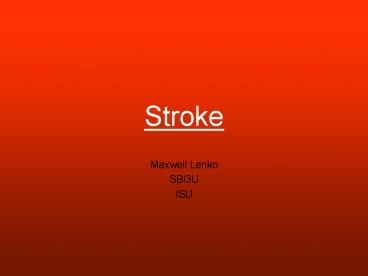Stroke - PowerPoint PPT Presentation
1 / 15
Title:
Stroke
Description:
Stroke Maxwell Lenko SBI3U ... Causes of Artery Rupture/ Clotting Immediate Symptoms Post-Stroke Symptoms Diagnosis Immediate Treatment Rehabilitation Current/Future ... – PowerPoint PPT presentation
Number of Views:445
Avg rating:3.0/5.0
Title: Stroke
1
Stroke
- Maxwell Lenko
- SBI3U
- ISU
2
Terms
- Blood Vessel a tube through which blood moves
through the body - Artery a blood vessel that carries blood
directly from the heart through the body - Hemorrhage the escape of blood into an extra
vascular area - Atherosclerosis the deposition of cholesterol
in an artery - Thrombosis a clot that forms in an artery and
blocks it - Embolism a dislodged clot that blocks another
artery
3
Definition
- A stroke is the damaging of brain cells due to
blood flow interruption - There are 3 types of strokes
- Ischemic Stroke
- Intracerebral Hemorrhage
- Subarachnoid Hemorrhage
4
Ischemic Stroke
- Responsible for 80 of all strokes
- Results from a clot in an artery in the brain,
either through thrombosis or embolism
www.memorylossonline.com/glossary/images/stroke.jp
g
5
Intracerebral Hemorrhage
- 12 of all strokes
- Artery in the brain suddenly ruptures releases
blood into the brain and compresses it - If blood builds up rapidly victim can become
unconscious - Usually occurs in the cerebellum, basal ganglia,
cortex or brain stem
http//www.dhushara.com/book/brainp/brainil/brain.
jpg
6
Subarachnoid Hemorrhage
- 8 of all strokes
- Caused by blood vessel rupture
- Different from intracerebral in that blood
surrounds the brain instead of filling it - Sudden build up of blood can cause
unconsciousness or even death - Said to cause the worst headache of ones life
http//www.strokecenter.org/pat/viewer/sah/sah_cor
onal_berry_2_500.jpg
7
Causes of Artery Rupture/ Clotting
- Controllable
- High Blood Pressure
- Cholesterol
- Smoking
- Atrial Fibrillation
- Diet
- Lack of Exercise
- Uncontrollable
- Over age 55
- Being Male
- African American
- Hispanic
- Asian/Pacific Islander
- Family history
- Diabetes
8
Immediate Symptoms
- Paralysis
- Sudden Weakness
- Unconsciousness
- Death (not as immediate)
- Loss of Speech
9
Post-Stroke Symptoms
- Involuntary Muscle Contraction
- Balance Problems
- Curling of Toes
- Central Pain Syndrome
- Aphasia (limited communication)
- Apraxia (difficulty initiating speech causing
movements ) - Auditory Overload ( inability to convert sound to
language ) - Dysarthia ( slurring of speech )
- Dysphagia ( food goes down air tube instead of
esophagus ) - Depression
- One-Side Neglect
- Behavioral Changes
- Other Subtle Brain Difficulties
10
Diagnosis
- Doctor can perform a number of tests
- Risk Factors
- Carotid Ultrasonography
- Arteriography
- Computerized Tomography (CAT scan)
- Magnetic Resonance Imaging (MRI)
11
Immediate Treatment
- For an ischemic stroke doctor will remove clot
using tissue plasminogen activator (tPA) drugs - For a hemorrhage a tiny clip is placed to close
the aneurysm or a coil is placed in it to prevent
further rupturing
12
Rehabilitation
- Occurs in either a hospital, subacute care unit,
rehab hospital, home therapy, home with
outpatient therapy, long term care facility - Therapists such as physicians and speech
therapists are required to re-establish basic
skills for independence - Nursing is very important
- Rehab time is dependent on damage to brain cells
13
Current/Future Research
- Research into implantable pacemakers, artificial
hearts, using acetylsalicylic acid in prevention
of strokes, clot dissolving drugs (eg. tPA),
increasing public awareness about strokes,
updating and developing new methods of CPR,
bionics, and the promotion of recommendations to
the public to deal with high blood pressure
14
Miscellaneous Facts
- 75 of all strokes are preventable
- One of the most common causes of death amongst
elders in the Western world - Third leading cause of death in America
- First leading cause of adult disability
- Women more likely to die
15
References
- ___ (1998). Stroke. In Encyclopedia of Family
Health (vol. 14, pp. 1876- 1881). Toronto
Marshall Cavendish. - American Stroke Association. Warning
Signs, Life After Stroke. Retrieved April 8,
2007 from the World Wide Web lt
http//www.strokeassociation.org/presenter.jhtml?i
dentifier12000372 gt - Mayo Clinic Staff. (2006). Mayo Clinic
Family Health Book Third Edition. New York.
Harper Collins Publishers. - National Stroke Association. Whats a
Stroke?, Risk Factors, Prevention,
Recovery. Retrieved April 8, 2007 on the World
Wide - Web lt http//www.stroke.org/site/PageServer?
pagenamehome gt. - The Internet Stroke Center. Types of
Stroke. Retrieved April 8, 2007 from the World
Wide Web - lt http//www.strokecenter.org/pat/stroke_types
.htm gt - The Heart and Stroke Foundation. All
about Research. Retrieved June 4, 2007 from the
World Wide Web lt http//ww2.heartandstroke.ca/Pag
e.asp?PageID1366ArticleID5533SrcblankFromSu
bCategory gt.































